HOW TO: Backup (Export) and Restore (Import) virtual machines to VMware vSphere Hypervisor 7.0 for FREE
EE Fellow, MVE, Expert of the Year 2021,2017-11, Scribe 2016-2012, Author of the Year 2018-6,2013-2012 VMware vExpert Pro, vExpert 2022-2011
Published:
Edited by: Andrew Leniart
Browse All Articles > HOW TO: Backup (Export) and Restore (Import) virtual machines to VMware vSphere Hypervisor 7.0 for FREE
In this article we will show you HOW TO: Backup (Export) and Restore (Import) virtual machines to VMware vSphere Hypervisor 7.0 for FREE. This procedure can be followed to backup (export) and restore (import) any virtual machine hosted on the VMware vSphere Hypervisor 7.0 host server.
In my previous Experts Exchange Articles , most have featured Basic and Intermediate VMware and Virtualisation Topics.
If you would like to read my Basic VMware articles, they are listed at the end of this article for your convenience.
In this series of basic VMware articles for the Novice, I'll be showing you the basic VMware skills required to install, configure and deploy virtual machines using VMware's FREE VMware vSphere Hypervisor (ESXi).
If you have been following this series, in Part 7: HOW TO: Create your first Windows Virtual Machine on a VMware vSphere Hypervisor 7.0 (ESXi 7.0) Host Server we created our first Microsoft Windows virtual machine called "My First Windows Virtual Machine", and in Part 9: HOW TO: Create your first Linux Virtual Machine on a VMware vSphere Hypervisor 7.0 (ESXi 7.0) Host Server, we created our first Linux virtual machine called "My First Linux Virtual Machine".
Later in this tutorial, we will be using these virtual machines to backup and restore. This procedure can be used to backup and restore any virtual machine hosted on VMware vSphere Hypervisor 7.0 (ESXi 7.0) Host Server.
Please refer to my EE Article - Part 2: HOW TO: Connect to the VMware vSphere Hypervisor 7.0 (ESXi 7.0) using the vSphere (HTML5 Web) Host Client 7.0.
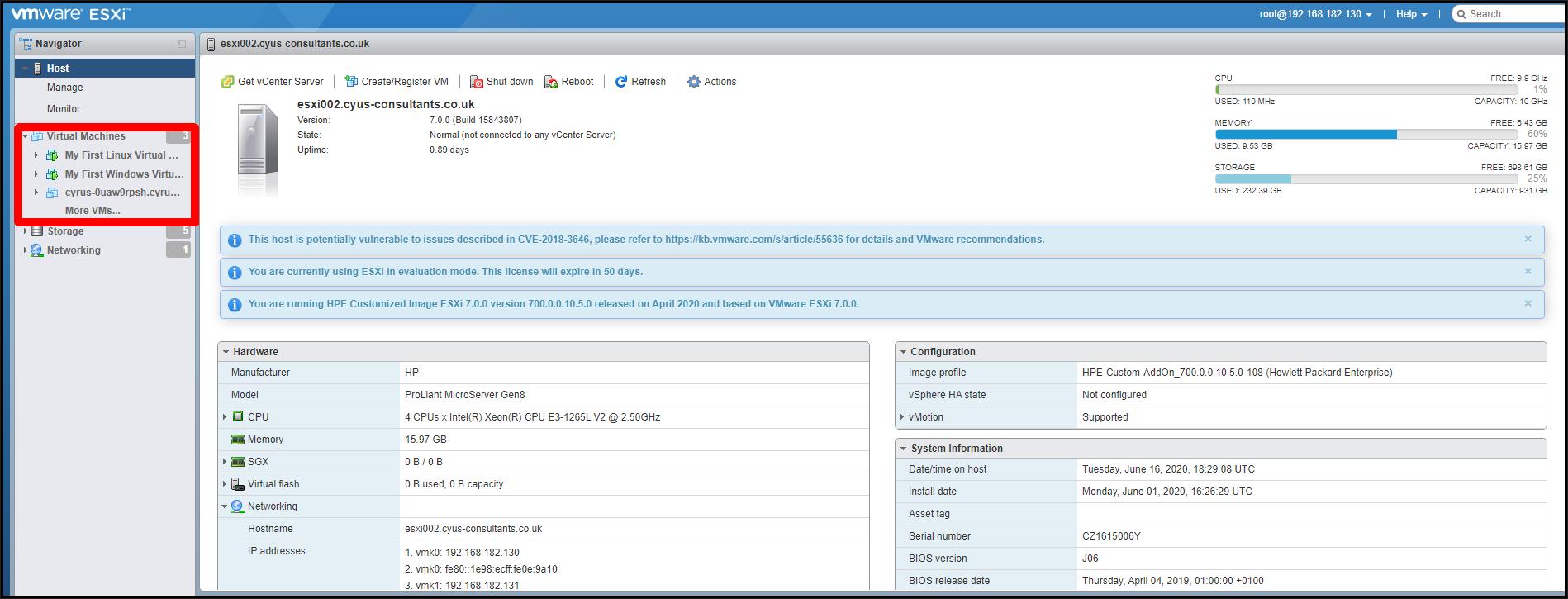
This procedure can only backup (export) the virtual machines when the virtual machine is powered off. So please ensure that the virtual machines are powered off, before you backup (export) the virtual machines, or you will get an error message. If you would like to back up the virtual machines when they are powered on this requires a third party commercial product.

You may have noticed in the inventory is the virtual machine - cyrus-0uaw9rpsh.cyrus-consultants.co.uk which we P2Ved in Part 14: HOW TO: P2V a Windows XP computer to VMware vSphere Hypervisor 7.0 (ESXi 7.0).
Right-click the virtual machine, you would like to back up (export) and select Guest OS > Shutdown.
Please note this will only function if you have installed VMware Tools for the virtual machine, this was covered here
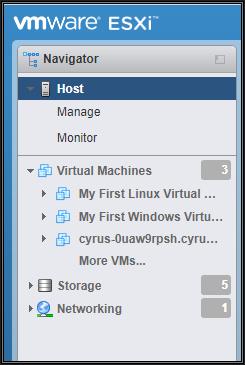
The virtual machines are powered off.
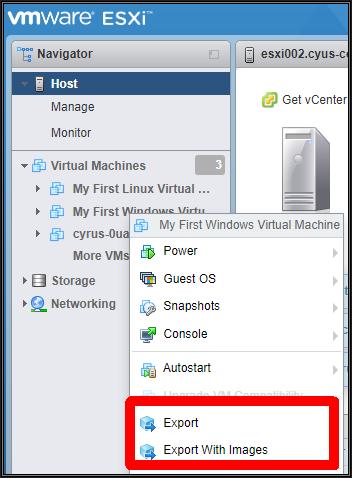
Right-click the virtual machine you wish to export and select Export. The function Export With Images is used if you wish to export the attached iso. (connected to the DVD-ROM drive).
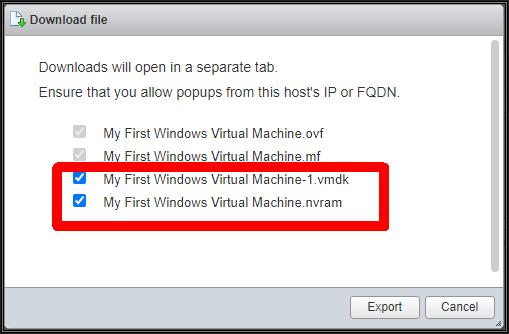
Ensure *.vmdk and *.nvram is ticked. Ensure that you allow pop-ups from this host's IP or FQDN. We will be using the Export function to backup the virtual machine. The Export function will back up the entire virtual machine to several files, including an OVF file. An OVF file is an Open Virtualization Format, OVF is an open standard for packaging and distributing virtual machines, sometimes referred to as virtual appliances. These files can also be restored to other Hypervisors e.g. Microsoft Hyper-V, Oracle Virtualbox. In past versions of ESXi, a single file was created, in ESXi 7.0, several files are downloaded. *.OVF, *.mf, *.VMDK and *.nvram.
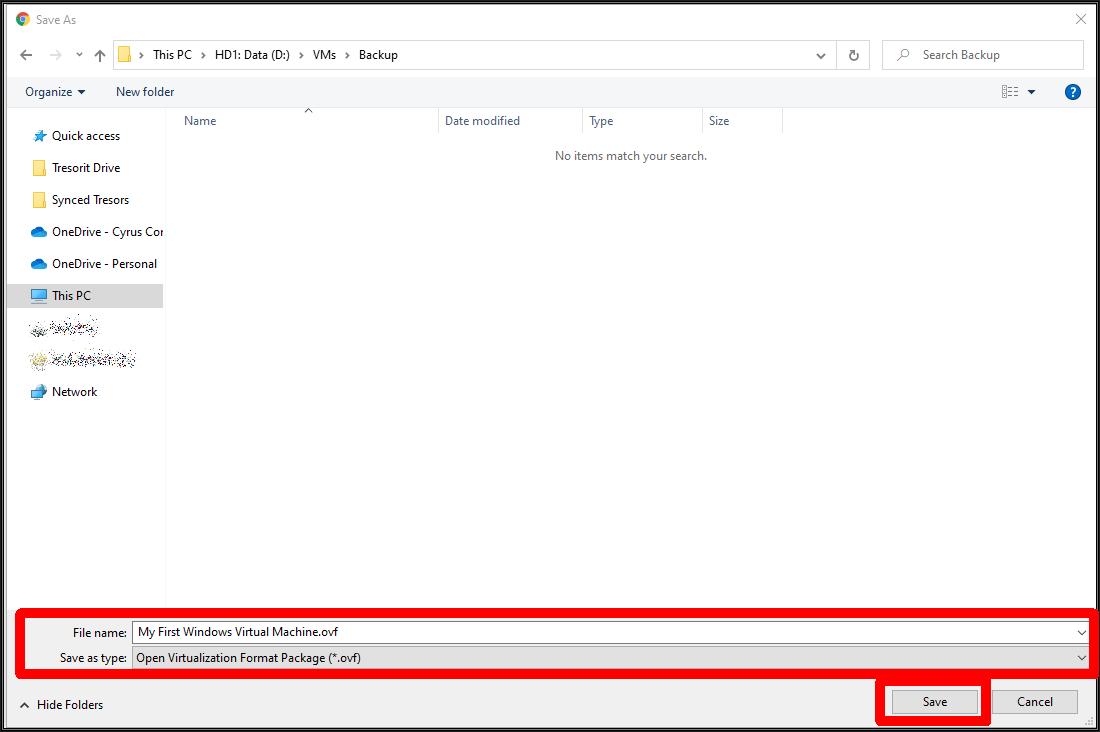
Select a download location on your computer, and repeat for all four files.

Be patient and wait, it can be a while for the export to occur. The status can be observed in the vSphere (HTML5) host Client. In my lab, it took about 6 minutes to export the virtual machine. Only the data used in the VMDK is exported.
Repeat Step 2 above, but select and Export (backup) " My First Linux Virtual Machine".
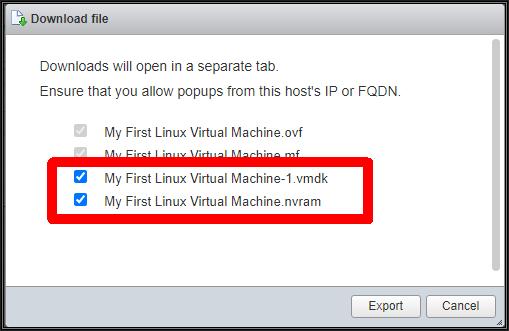
Select the backup folder on the local workstation, in this tutorial it was D:\VMs\Backup.
You should have eight files as follows:-
All these files are required for a successful Import (restore).
An ANDY TOP TIP Please ensure you have tested and restored your virtual machine from an OVF file before deleting your virtual machine from the host server. Many VMware Administrators, delete their virtual machines before checking they have a backup that can be successfully restored. See step 5 below.
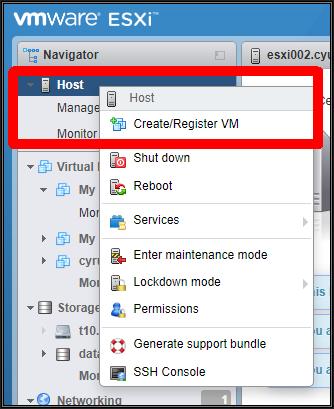
Select the Host, Right-click and select Create/Register VM

At the virtual machine wizard, select Deploy a virtual machine from an OVF or OVA file followed by Next to continue.
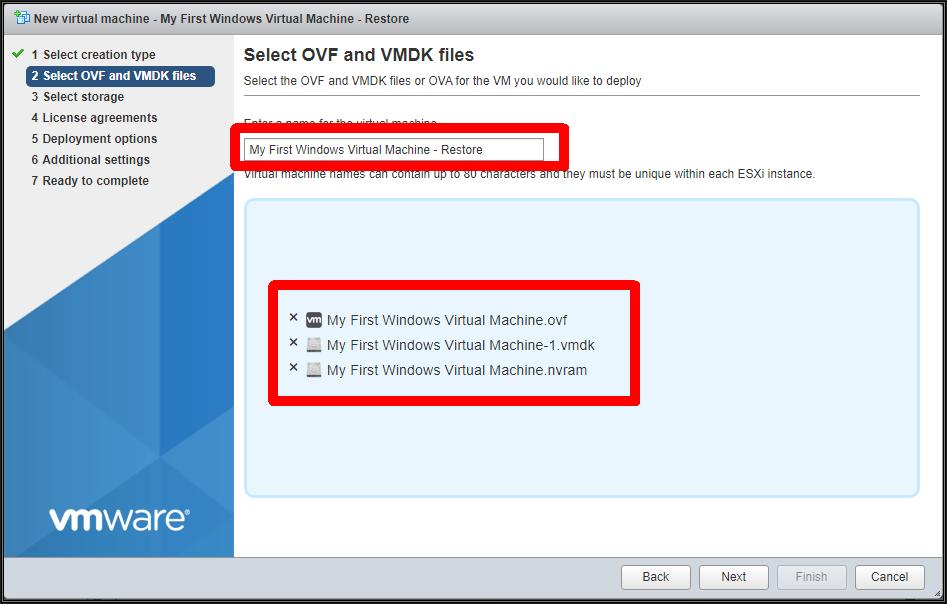
Enter a new, different name for the virtual machine inventory name, all virtual machines in the VMware Hypervisor inventory must be unique. This is not the operating system hostname, it could be the same name as the operating system hostname, this is just a cosmetic name for the inventory. In this tutorial, I have entered the name My First Windows Virtual Machine Restore. Select or drag and drop the files. Click Next to continue.
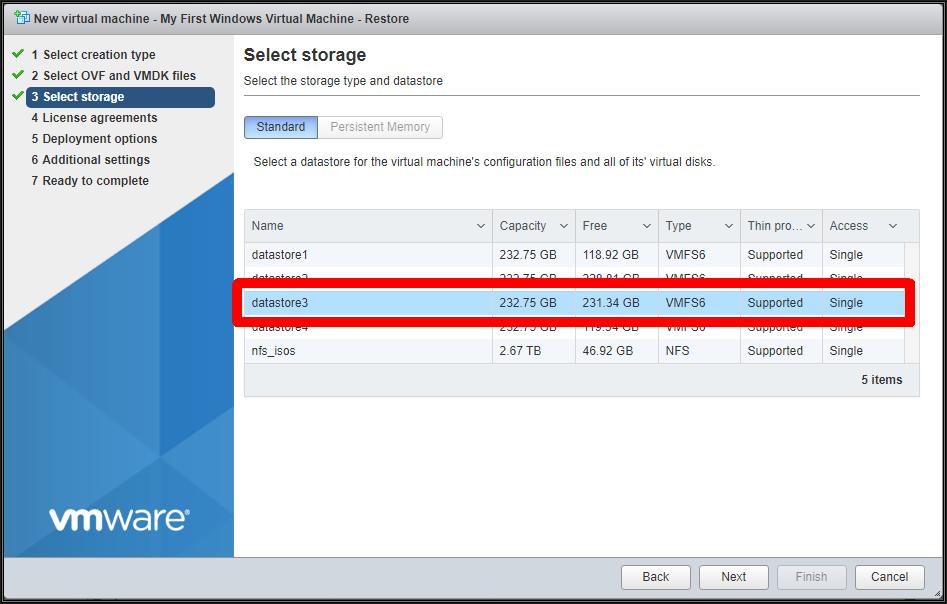
Select a datastore, I have selected datastore3. Click Next to continue.
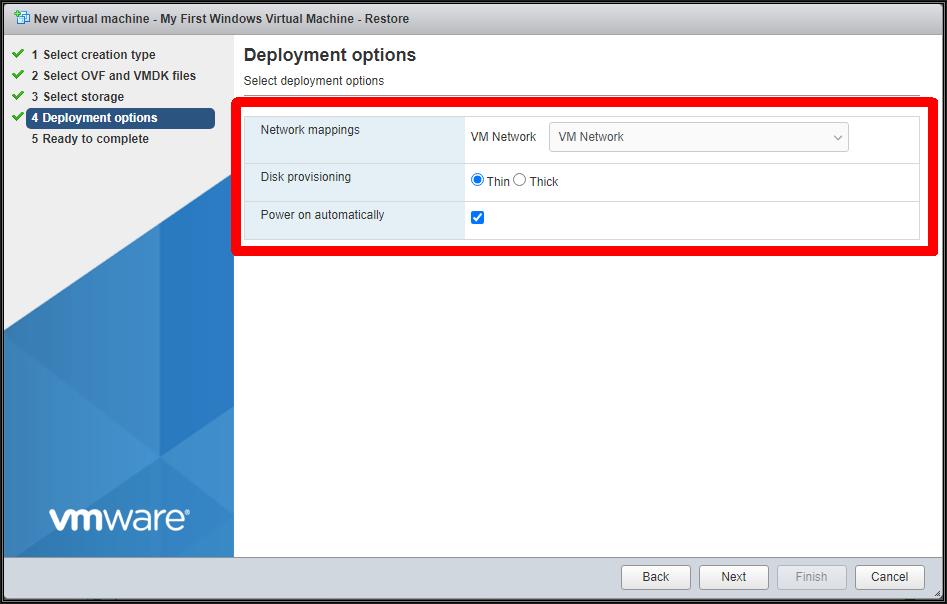
Select Thin.
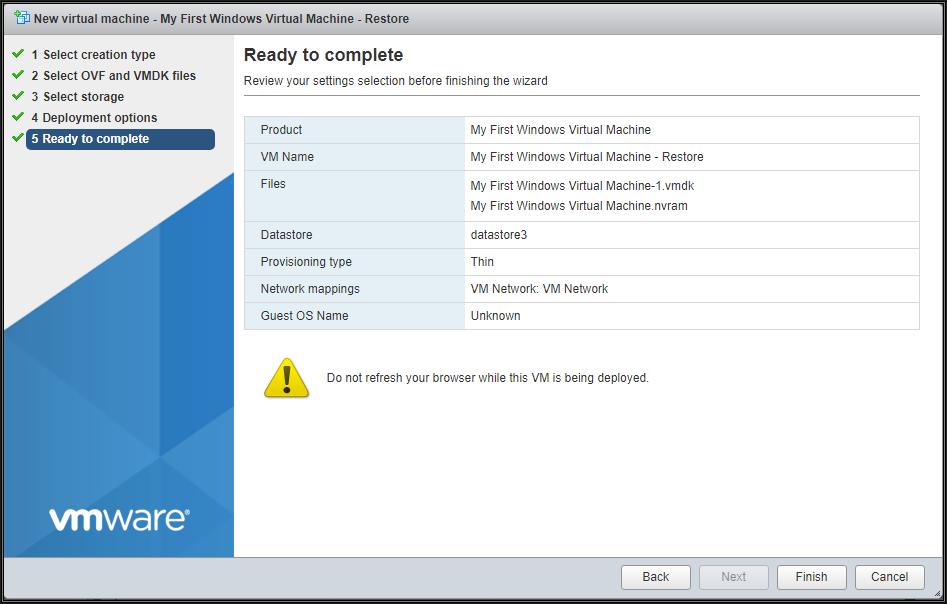
At the Ready to complete Summary Page, review the summary information, and click Finish.

The virtual machine will start to be imported, this can take a few minutes to many hours depending upon the size of the virtual machine. The Task will be visible in the vSphere Host Client.

The virtual machine My First Windows Virtual Machine Restore has been successfully restored and is listed in the inventory.
Repeat Step 5 above, but select and Import (restore) " My First Linux Virtual Machine".
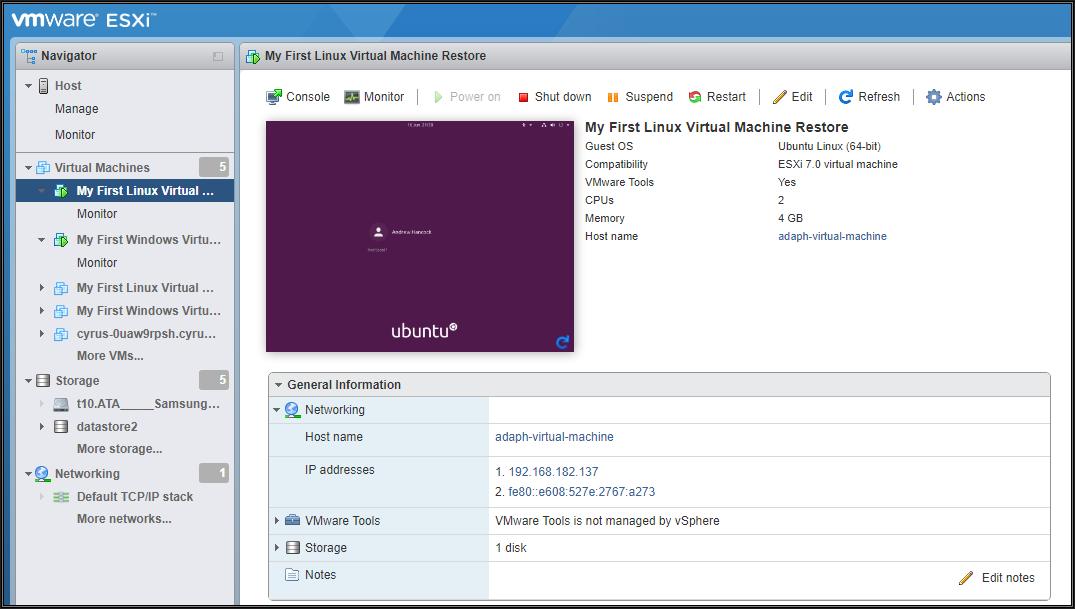
Restores (Imports) completed successfully, all the virtual machines are shown in the inventory.
Congratulations, you have successfully completed a Backup (Export) and Restore (Import) of a Windows and Linux virtual machines to VMware vSphere Hypervisor 7.0 (ESXi 7.0).
If you require scheduled backup and restore, or the ability to backup virtual machines which are powered on, we would recommend you try the following commercial backup products.
Acronis Backup & Recovery
Arcserve
Broadcom Backup and Restore
Commvault
Microfocus VM Explorer
NAKIVO Backup & Replication for VMware
Quest Rapid Recovery
StorageCraft Shadow Protect Server
Unitrends - Unitrends: All-in-One Data Backup Solutions and Disaster Recovery
Veeam Backup & Replication v10
Basic VMware Articles Series:
These articles are also applicable to VMware vSphere Hypervisor ESXi 5.0, 5.5, 6.0.
These articles are applicable to VMware vSphere Hypervisor 6.5.
These articles are applicable to VMware vSphere Hypervisor 6.7.
Previous articles in this VMware vSphere 7.0 series are here.
If you found this tutorial helpful, please do click the Thumbs-Up icon below. This lets me know what is valuable for EE members and provides direction for future articles. If you have a related question based on this article, please click here.
Thank you very much!
Regards, Andy
If you would like to read my Basic VMware articles, they are listed at the end of this article for your convenience.
In this series of basic VMware articles for the Novice, I'll be showing you the basic VMware skills required to install, configure and deploy virtual machines using VMware's FREE VMware vSphere Hypervisor (ESXi).
If you have been following this series, in Part 7: HOW TO: Create your first Windows Virtual Machine on a VMware vSphere Hypervisor 7.0 (ESXi 7.0) Host Server we created our first Microsoft Windows virtual machine called "My First Windows Virtual Machine", and in Part 9: HOW TO: Create your first Linux Virtual Machine on a VMware vSphere Hypervisor 7.0 (ESXi 7.0) Host Server, we created our first Linux virtual machine called "My First Linux Virtual Machine".
Later in this tutorial, we will be using these virtual machines to backup and restore. This procedure can be used to backup and restore any virtual machine hosted on VMware vSphere Hypervisor 7.0 (ESXi 7.0) Host Server.
1. Connect to the VMware vSphere Hypervisor 7.0 (ESXi 7.0) or vSphere vCenter Server using the vSphere (HTML5) Host Client.
Please refer to my EE Article - Part 2: HOW TO: Connect to the VMware vSphere Hypervisor 7.0 (ESXi 7.0) using the vSphere (HTML5 Web) Host Client 7.0.

This procedure can only backup (export) the virtual machines when the virtual machine is powered off. So please ensure that the virtual machines are powered off, before you backup (export) the virtual machines, or you will get an error message. If you would like to back up the virtual machines when they are powered on this requires a third party commercial product.

You may have noticed in the inventory is the virtual machine - cyrus-0uaw9rpsh.cyrus-consultants.co.uk which we P2Ved in Part 14: HOW TO: P2V a Windows XP computer to VMware vSphere Hypervisor 7.0 (ESXi 7.0).
Right-click the virtual machine, you would like to back up (export) and select Guest OS > Shutdown.
Please note this will only function if you have installed VMware Tools for the virtual machine, this was covered here
2. Virtual Machine Backup (Export) of My First Windows Virtual Machine to OVF

The virtual machines are powered off.

Right-click the virtual machine you wish to export and select Export. The function Export With Images is used if you wish to export the attached iso. (connected to the DVD-ROM drive).

Ensure *.vmdk and *.nvram is ticked. Ensure that you allow pop-ups from this host's IP or FQDN. We will be using the Export function to backup the virtual machine. The Export function will back up the entire virtual machine to several files, including an OVF file. An OVF file is an Open Virtualization Format, OVF is an open standard for packaging and distributing virtual machines, sometimes referred to as virtual appliances. These files can also be restored to other Hypervisors e.g. Microsoft Hyper-V, Oracle Virtualbox. In past versions of ESXi, a single file was created, in ESXi 7.0, several files are downloaded. *.OVF, *.mf, *.VMDK and *.nvram.

Select a download location on your computer, and repeat for all four files.

Be patient and wait, it can be a while for the export to occur. The status can be observed in the vSphere (HTML5) host Client. In my lab, it took about 6 minutes to export the virtual machine. Only the data used in the VMDK is exported.
3. Virtual Machine Backup (Export) of My First Linux Virtual Machine to OVF.
Repeat Step 2 above, but select and Export (backup) " My First Linux Virtual Machine".

4. Examination of the exported (backup) files in the backup folder
Select the backup folder on the local workstation, in this tutorial it was D:\VMs\Backup.
You should have eight files as follows:-
- My First Windows Virtual Machine.nvram
- My First Windows Virtual Machine.ovf
- My First Windows Virtual Machine-1.vmdk
- My First Windows Virtual Machine.mf
- My First Linux Virtual Machine.nvram
- My First Linux Virtual Machine.ovf
- My First Linux Virtual Machine-1.vmdk
- My First Windows Virtual Machine.mf
All these files are required for a successful Import (restore).
An ANDY TOP TIP Please ensure you have tested and restored your virtual machine from an OVF file before deleting your virtual machine from the host server. Many VMware Administrators, delete their virtual machines before checking they have a backup that can be successfully restored. See step 5 below.
5. Virtual Machine Restore (Import) of My First Windows Virtual Machine from an OVF.

Select the Host, Right-click and select Create/Register VM

At the virtual machine wizard, select Deploy a virtual machine from an OVF or OVA file followed by Next to continue.

Enter a new, different name for the virtual machine inventory name, all virtual machines in the VMware Hypervisor inventory must be unique. This is not the operating system hostname, it could be the same name as the operating system hostname, this is just a cosmetic name for the inventory. In this tutorial, I have entered the name My First Windows Virtual Machine Restore. Select or drag and drop the files. Click Next to continue.

Select a datastore, I have selected datastore3. Click Next to continue.

Select Thin.

At the Ready to complete Summary Page, review the summary information, and click Finish.

The virtual machine will start to be imported, this can take a few minutes to many hours depending upon the size of the virtual machine. The Task will be visible in the vSphere Host Client.

The virtual machine My First Windows Virtual Machine Restore has been successfully restored and is listed in the inventory.
6. Virtual Machine Restore (Import) of My First Linux Virtual Machine from an OVF.
Repeat Step 5 above, but select and Import (restore) " My First Linux Virtual Machine".

Restores (Imports) completed successfully, all the virtual machines are shown in the inventory.
Congratulations, you have successfully completed a Backup (Export) and Restore (Import) of a Windows and Linux virtual machines to VMware vSphere Hypervisor 7.0 (ESXi 7.0).
If you require scheduled backup and restore, or the ability to backup virtual machines which are powered on, we would recommend you try the following commercial backup products.
Acronis Backup & Recovery
Arcserve
Broadcom Backup and Restore
Commvault
Microfocus VM Explorer
NAKIVO Backup & Replication for VMware
Quest Rapid Recovery
StorageCraft Shadow Protect Server
Unitrends - Unitrends: All-in-One Data Backup Solutions and Disaster Recovery
Veeam Backup & Replication v10
Basic VMware Articles Series:
These articles are also applicable to VMware vSphere Hypervisor ESXi 5.0, 5.5, 6.0.
These articles are applicable to VMware vSphere Hypervisor 6.5.
These articles are applicable to VMware vSphere Hypervisor 6.7.
Previous articles in this VMware vSphere 7.0 series are here.
- Part 7: HOW TO: Create your first Windows Virtual Machine on a VMware vSphere Hypervisor 7.0 (ESXi 7.0) Host Server
If you found this tutorial helpful, please do click the Thumbs-Up icon below. This lets me know what is valuable for EE members and provides direction for future articles. If you have a related question based on this article, please click here.
Thank you very much!
Regards, Andy
Have a question about something in this article? You can receive help directly from the article author. Sign up for a free trial to get started.


Comments (0)